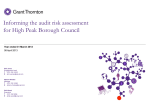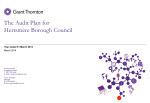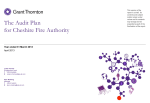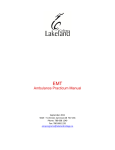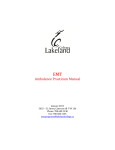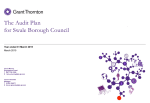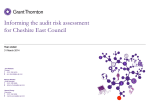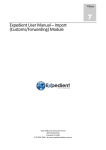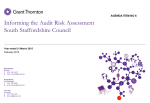Download The Audit Plan – template user guide
Transcript
Informing the audit risk assessment for Staffordshire Moorlands District Council Year ended 31 March 2013 17 May 2013 Phil Jones Engagement Lead T 0121 232 5232 E [email protected] Allison Rhodes Manager T 0121 232 5285 E [email protected] Phil Wood Executive T 0121 232 5256 E [email protected] © 2013 Grant Thornton UK LLP | Informing the risk assessment | May 13 1 The contents of this report relate only to the matters which have come to our attention, which we believe need to be reported to you as part of our audit process. It is not a comprehensive record of all the relevant matters, which may be subject to change, and in particular we cannot be held responsible to you for reporting all of the risks which may affect your business or any weaknesses in your internal controls. This report has been prepared solely for your benefit and should not be quoted in whole or in part without our prior written consent. We do not accept any responsibility for any loss occasioned to any third party acting, or refraining from acting on the basis of the content of this report, as this report was not prepared for, nor intended for, any other purpose. 2 . Contents Section Page Purpose 4 Fraud 5 Fraud Risk Assessment Laws and Regulations Impact of Laws and Regulations Going Concern Going Concern Considerations Estimates Estimate considerations 6-8 9 10 - 11 12 13 – 14 15 16 - 19 Related Parties 20 Related Parties consideration 21 © 2013 Grant Thornton UK LLP | Informing the risk assessment | May 13 3 Purpose The purpose of this report is to contribute towards the effective two-way communication between auditors and the Council's Audit and Accounts Committee , as 'those charged with governance'. The report covers some important areas of the auditor risk assessment where we are required to make inquiries of the Audit and Accounts Committee under auditing standards Background Under International Standards on Auditing (UK and Ireland) (ISA(UK&I)) auditors have specific responsibilities to communicate with the Audit Committee. ISA(UK&I) emphasise the importance of two-way communication between the auditor and the Audit Committee and also specify matters that should be communicated. This two-way communication assists both the auditor and the Audit Committee in understanding matters relating to the audit and developing a constructive working relationship. It also enables the auditor to obtain information relevant to the audit from the Audit Committee and supports the Audit Committee in fulfilling its responsibilities in relation to the financial reporting process. Communication As part of our risk assessment procedures we are required to obtain an understanding of management processes and the Audit and Accounts Committee's oversight of the following areas: •fraud •laws and regulations •going concern •accounting estimates •related party transactions This report includes a series of questions on each of these areas and the response we have received from the Council's management. The Audit and Accounts Committee should consider whether these responses are consistent with the its understanding and whether there are any further comments it wishes to make. © 2013 Grant Thornton UK LLP | Informing the risk assessment | May 13 4 Fraud Issue Matters in relation to fraud ISA(UK&I)240 covers auditors responsibilities relating to fraud in an audit of financial statements. The primary responsibility to prevent and detect fraud rests with both the Audit and Accounts Committee and management. Management, with the oversight of the Audit and Accounts Committee, needs to ensure a strong emphasis on fraud prevention and deterrence and encourage a culture of honest and ethical behaviour. As part of its oversight, the Audit and Accounts Committee should consider the potential for override of controls and inappropriate influence over the financial reporting process. As auditor, we are responsible for obtaining reasonable assurance that the financial statements are free from material misstatement due to fraud or error. We are required to maintain professional scepticism throughout the audit, considering the potential for management override of controls. As part of our audit risk assessment procedures we are required to consider risks of fraud. This includes considering the arrangements management has put in place with regard to fraud risks including: •assessment that the financial statements could be materially misstated due to fraud •process for identifying and responding to risks of fraud, including any identified specific risks •communication with the Audit and Accounts Committee regarding its processes for identifying and responding to risks of fraud •communication to employees regarding business practices and ethical behaviour. We need to understand how the Audit and Accounts Committee oversees the above processes. We are also required to make inquiries of both management and the Audit and Accounts Committee as to their knowledge of any actual, suspected or alleged fraud. These areas have been set out in the fraud risk assessment questions below together with responses from the Council's management. © 2013 Grant Thornton UK LLP | Informing the risk assessment | May 13 5 Fraud risk assessment Question Management response (please also consider in the context of group accounts) Has the Council assessed the risk of material misstatement in the financial statements due to fraud? What are the results of this process? Yes. The underlying management processes are primarily as described in the Annual Governance Statement, which is published alongside the Statement of Accounts. These are strengthened by additional procedures specific to the Statement of Accounts. For example, the Chief Finance Officer undertakes a detailed review of the draft Accounts and will not issue a certificate until satisfactory answers and assurances have been provided. We conclude that there is no significant risk of material misstatement in the Statement of Accounts due to fraud. What processes does the Council have in place to identify and respond to risks of fraud? There are a number of policies and procedures in place including an Anti-Fraud and Corruption Policy, RIPA Policy & Procedures, Whistleblowing Policy, risk management arrangements set out in the risk management policy, strategy and process, participation in the NFI, Benefit Fraud Investigation Team. Internal Audit is also 'good practice compliant' and has a proven track record in planning audit work to take account of fraud risks and responding appropriately to fraud risks in the organisation and enhancing controls to protect against the risk of fraud (e.g. procurement arrangements). Have any specific fraud risks, or areas with a No specific fraud risks or areas with a high risk of fraud have been identified. However, the Council is always high risk of fraud, been identified and what has vigilant to the threat of fraud and Internal Audit work is planned to highlight the threat of potential fraud, been done to mitigate these risks? including completion of external audit fraud checklists. Are internal controls, including segregation of duties, in place and operating effectively? If not, where are the risk areas and what mitigating actions have been taken? Overall internal controls work effectively and Internal Audit report on ineffective controls which are corrected by management. Are there any areas where there is a potential for override of controls or inappropriate influence over the financial reporting process (for example because of undue pressure to achieve financial targets)? Not significantly. Financial and operational targets are an important part of the management process. However, a strong corporate commitment to appropriate ethical behaviour outweighs any pressure to meet targets. © 2013 Grant Thornton UK LLP | Informing the risk assessment | May 13 6 Fraud risk assessment Question Management response Are there any areas where there is a potential for Controls are in place to minimise risk. misreporting override of controls or inappropriate influence over the financial reporting process? How does the Audit and Accounts Committee exercise oversight over management's processes for identifying and responding to risks of fraud? What arrangements are in place to report fraud issues and risks to the Audit and Accounts Committee? The Audit and Accounts Committee provides oversight through : Review and approval of policies and procedures including an Anti-Fraud and Corruption Policy, Regulation of Investigatory Powers Act and Whistleblowing Policy; Review of risk management arrangements set out in the risk management policy, strategy and process; Review of Internal Audit progress reports; Review of Internal Audit Annual Report, which includes the opinion on the control environment; Receiving periodic updates on the outcome of any fraud investigative work; Receiving updates on actions taken to enhance controls and protect against the risk of fraud e.g. procurement arrangements; and Consideration of reports from External Audit and any action plans setting out recommendations made. Procedures dictate that the Chair of the Audit and Accounts Committee is informed of any matters of actual, suspected or alleged fraud (with notification to the Audit and Accounts Committee subject to confidentiality). How does the Council communicate and encourage ethical behaviour of its staff and contractors? There are a number of policies and procedures in place which are reviewed and approved by the Standards Committee including the Ethical Framework (inc. Code of Corporate Governance), a Staff Code of Conduct, Registers for Interests and Gifts & Hospitality. Such policies and procedures are the subject of a detailed communications process, which includes extensive coverage during induction and training. How do you encourage staff to report their concerns about fraud? Have any significant issues been reported? © 2013 Grant Thornton UK LLP | Informing the risk assessment | May 13 The Council has a well publicised Whistleblowing Policy. No significant issues have been reported. 7 Fraud risk assessment Question Management response Are you aware of any related party relationships or transactions that could give rise to risks of fraud? Not aware of any related party relationships or transactions that could give rise to instances of fraud. Are you aware of any instances of actual, suspected or alleged, fraud, either within the Council as a whole or within specific departments since 1 April 2012? Confirmation from the Monitoring Officer, Chief Financial Officer (CFO), Audit Manager, Legal Services Manager and Finance and Procurement Manager has been obtained that no significant frauds have been identified during 2012/13. © 2013 Grant Thornton UK LLP | Informing the risk assessment | May 13 Monitoring and controls in place mitigate the risk. 8 Laws and regulations Issue Matters in relation to laws and regulations ISA(UK&I)250 requires us to consider the impact of laws and regulations in an audit of the financial statements. Management, with the oversight of the Audit and Accounts Committee, is responsible for ensuring that the Council's operations are conducted in accordance with laws and regulations including those that determine amounts in the financial statements. As auditor, we are responsible for obtaining reasonable assurance that the financial statements are free from material misstatement due to fraud or error, taking into account the appropriate legal and regulatory framework. As part of our risk assessment procedures we are required to make inquiries of management and the Audit and Accounts Committee as to whether the entity is in compliance with laws and regulations. Where we become aware of information of non-compliance or suspected non-compliance we need to gain an understanding of the non-compliance and the possible effect on the financial statements. Risk assessment questions have been set out below together with responses from management. © 2013 Grant Thornton UK LLP | Informing the risk assessment | May 13 9 Impact of laws and regulations Question Management response (please also consider in the context of group accounts) What arrangements does the Council have in place to prevent and detect non-compliance with laws and regulations? The operation of the statutory officer roles (Head of Paid Services, Monitoring Officer and Chief Financial Officer) help to ensure compliance with laws and regulations. For example, the Monitoring Officer has the authority to report to Council if he considers that any proposal, decision or omission would give rise to unlawfulness or maladministration, thereby stopping the proposal or decision being implemented until the report has been considered. Legal implications are outlined in all committee reports. How does management gain assurance that all relevant laws and regulations have been complied with? The operation of the statutory officer roles (Head of Paid Services, Monitoring Officer and Chief Financial Officer) help to provide assurance that laws and regulations are complied with. The Internal Audit service operates to the standards set out in the “Code of Practice for Internal Audit in local Government in the United Kingdom” and the Internal Audit Plan specifically considers compliance with laws and regulations. The Council has a well publicised Whistleblowing Policy. How is the Audit and Accounts Committee provided with assurance that all relevant laws and regulations have been complied with? The Chief Financial Officer attends Audit and Accounts committee meetings to respond to members enquiries. Standard reporting formats requires that legal implications are outlined in all committee reports. The Audit Manager has a number of alternative reporting lines in the event of breach of law or regulation, including a right to meet privately with the Chair of the Audit and Accounts or the Committee in full, should the situation determine such an approach necessary. Have there been any instances of nonConfirmation from the Monitoring Officer, Chief Financial Officer (CFO), Audit Manager, Legal Services compliance or suspected non-compliance with Manager and Finance and Procurement Manager has been obtained that no instances of non-compliance or law and regulation since 1 April 2012, or earlier suspected non-compliance with laws and regulations have been identified during 2012/13. with an on-going impact on the 2012/13 financial statements? © 2013 Grant Thornton UK LLP | Informing the risk assessment | May 13 10 Impact of laws and regulations Question Management response (please also consider in the context of group accounts) What arrangements does the Council have in place to identify, evaluate and account for litigation or claims? The Council has embedded systems and procedures in place to deal with litigation and claims as they emerge (e.g. the “Link Officer” in respect of Ombudsman issues). Is there any actual or potential litigation or claims that would affect the financial statements? Areas of litigation are reported in the Statements where their impact is considered material or significant to the readers of the statements and the outturn itself. Have there been any reports from other regulatory bodies, such as HM Revenues and Customs which indicate noncompliance? No. © 2013 Grant Thornton UK LLP | Informing the risk assessment | May 13 At year end, additional procedures ensure that any such items are reflected in the financial statements if appropriate. This is incorporated within closedown procedures and includes specific enquiries of all senior management with a particular emphasis on the Legal Services Manager, the Insurance Officer and the Customer Services Manager (responsible for the Ombudsman related issues). 11 Going concern Issue Matters in relation to going concern ISA(UK&I)570 covers auditor responsibilities in the audit of financial statements relating to management's use of the going concern assumption in the financial statements. The going concern assumption is a fundamental principle in the preparation of financial statements. Under this assumption entities are viewed as continuing in business for the foreseeable future. Assets and liabilities are recorded on the basis that the entity will be able to realise its assets and discharge its liabilities in the normal course of business. The code of practice on local authority accounting requires an authority’s financial statements to be prepared on a going concern basis. Although the Council is not subject to the same future trading uncertainties as private sector entities, consideration of the key features of the going concern provides an indication of the Council's financial resilience. As auditor, we are responsible for considering the appropriateness of use of the going concern assumption in preparing the financial statements and to consider whether there are material uncertainties about the Council's ability to continue as a going concern that need to be disclosed in the financial statements. We discuss the going concern assumption with management and review the Council's financial and operating performance. Going concern considerations have been set out below and management has provided its response. © 2013 Grant Thornton UK LLP | Informing the risk assessment | May 13 12 Going concern considerations Question Management response Does the Council have procedures in place to assess the Council's ability to continue as a going concern? Yes. There is a firmly embedded Financial Planning process, which includes a rolling Medium-Term Financial Plan that is updated three times annually. Other features include CFO assessments and statements regarding budget estimates and the adequacy of reserves and balances. Is management aware of the existence of other No. All such known events are systematically mitigated. For example, budget deficits are primarily addressed events or conditions that may cast doubt on the through a well developed approach towards the achievement of efficiency savings, which has a proven track Council's ability to continue as a going record of success. concern? Are arrangements in place to report the going Yes. concern assessment to the Audit and Accounts Committee? Are the financial assumptions (eg future levels Yes. Well established quarterly reporting process to councillors, combined with performance reporting against the of income and expenditure) consistent with the Council’s corporate plans and targets. Council's Business Plan and the financial information provided to the Council throughout the year? © 2013 Grant Thornton UK LLP | Informing the risk assessment | May 13 13 Going concern considerations Question Management response Are the implications of statutory or policy changes appropriately reflected in the Business Plan, financial forecasts and report on going concern? Yes. For example, the Medium-Term Financial Plan specifically includes consideration of both national (e.g. statutory) and local (e.g. policy) issues in terms of their potential financial impact. Have there been any significant issues raised No significant issues have been raised. with the Audit and Accounts Committee during the year which could cast doubts on the assumptions made? (Examples include adverse comments raised by internal and external audit regarding financial performance or significant weaknesses in systems of financial control). Does a review of available financial information No. Financial information is closely monitored as a matter of routine through firmly established processes. identify any adverse financial indicators including negative cash flow? If so, what action is being taken to improve financial performance? Does the Council have sufficient staff in post, with the appropriate skills and experience, particularly at senior manager level, to ensure the delivery of the Council’s objectives? If not, what action is being taken to obtain those skills? © 2013 Grant Thornton UK LLP | Informing the risk assessment | May 13 Yes. Staffing numbers are adequate. If and when numbers or experience is considered lacking, additional resource is brought in from third parties. 14 Estimates Issue Matters in relation to accounting estimates ISA (UK&I) 540 covers auditor responsibilities relating to estimates in an audit of financial statements. Local authorities use estimates in the preparation of their financial statements. We need to obtain an understanding of •how management identifies the transactions, events and conditions that give rise to the need for an accounting estimate. •how management actually make the estimates, including the control procedures in place to minimise the risk of misstatement. We need to be aware of all estimates that the Council use as part of their accounts preparation. These are set out overleaf (please also consider in the context of group accounts). © 2013 Grant Thornton UK LLP | Informing the risk assessment | May 13 15 Estimate considerations Underlying assumptions Estimate Method Property plant & equipment valuations Valuations for land and buildings are made by the external valuer in line with RICS guidance on the basis of 5 year valuations with interim reviews. Controls used to identify estimates Use of an expert Capital Accountant notifies the valuer of the program of rolling valuations or of any conditions that warrant an interim re-valuation Use external RICS Valuations are made in-line with RICS No valuer for buildings guidance – reliance on expert. valuations. Assumptions are set out in valuers report. Other assets considered by Services Manager and capital accountant For other assets…..no revaluation but asset lives reviewed based on the operational experience of the service areas. Specific asset lives applied to buildings. Use external RICS valuer for Buildings. The method makes some generalisations. For example, building lives would vary depending on the construction materials used. This life would be recorded in accordance with RICS valuation. Other assets are valued on the basis of depreciated historic cost as proxy for fair value as relatively short asset lives before replacement. Estimated remaining useful lives of PPE The following asset categories have general asset lives: •Buildings range 30 to 70 years •Equipment/ vehicles 3 to 15 years •Plant 3 to 15 years •Infrastructure 25 years Change in - Assessment of degree of uncertainty accounting - Consideration of alternative method in estimates year? Consistent asset lives applied to each asset category. Other assets considered by Property Services Manager and capital accountant Detailed information is included in the valuers report for each asset. The lives used for other assets are based on operational experience of the service areas. The asset live is then recorded in the asset register. © 2013 Grant Thornton UK LLP | Informing the risk assessment | May 13 16 No Estimate considerations Underlying assumptions Controls used to identify estimates - Consideration of alternative Use of an expert estimates Change in accounting method in year? Depreciation is provided for all fixed assets with a finite useful life on a straight-line basis. Consistent application of depreciation method across all assets No The length of the life is determined at the point of acquisition or revaluation. Major components are depreciated separately. No. Assets are assessed at the year-end for any indication that an asset may be impaired. Where indications exist and any possible differences are estimated to be material, the recoverable amount of the asset is estimated and, where this is less than the carrying amount of the asset, an impairment loss is recognised for the shortfall. Assets are assessed at each year-end as to whether there is any indication that an asset may be impaired. This assessment is made by the external valuer for land and buildings and by Property Services Manager and capital accountant (and other relevant officers for the asset type) for other assets. External RICS valuer. Valuations are made in-line with RICS guidance - reliance on expert. No At the inception of the lease the liability is the lower of the fair value of the asset or present value of the minimum lease payments. Payments are split between the finance charge and the element that reduces the liability. Finance review contracts and payments over the deminimus level to ensure the lease is categorised correctly as a finance lease or an operating lease. Calculations supported by lease documents. May obtain guidance to support lease classifications. - Assessment of degree of uncertainty Estimate Method Depreciation & Amortisation Impairments Finance lease liability © 2013 Grant Thornton UK LLP | Informing the risk assessment | May 13 17 Other assets considered by Property Services Manager and capital accountant Assets recognised under finance leases are accounted for using the policies applied generally to such assets, subject to depreciation being charged over the lease term if this is shorter than the asset’s estimated useful life (where ownership of the asset does not transfer to the Council at the end of the lease period). Estimate considerations Underlying assumptions - Assessment of degree of uncertainty Change in accounting method in year? Controls used to identify estimates - Consideration of alternative Use of an expert estimates S151 Officer makes the assessment. If the event is indicative of conditions that arose after the balance sheet date then this is an unadjusting event. For these events only a note to the accounts is included, identifying the nature of the event and where possible estimates of the financial effect Managers notify the S151 Officer This would be considered on individual circumstances This would be considered on individual circumstances N/A Allocation of overhead costs The finance team apportion central support costs to services using specified bases as detailed in supporting analysis. All support service cost centres are allocated according to the agreed principles. No Apportionment bases are reviewed each year to ensure that remain appropriate and equitable No Measurement of Financial Instruments. Council values financial instruments at fair value based on the advice of their internal treasury consultants and other finance professionals Take advice from finance professionals Yes Take advice from finance professionals No Estimate Method Non adjusting events - events after the BS date © 2013 Grant Thornton UK LLP | Informing the risk assessment | May 13 18 Estimate considerations Underlying assumptions Controls used to identify estimates Use of an expert - Assessment of degree of uncertainty Estimate Method Bad Debt Provision. A provision is estimated using a proportion basis of an aged debt listing. The finance team obtain the aged debt listing from the sales ledger and calculate the provision No Consistent proportion used across aged debt as per the Code. No Provisions for liabilities. Provisions are made where an event has taken place that gives the Council a legal or constructive obligation that probably requires settlement by a transfer of economic benefits or service potential, and a reliable estimate can be made of the amount of the obligation. Provisions are charged as an expense to the appropriate service line in the CI&ES in the year that the Council becomes aware of the obligation, and are measured at the best estimate at the balance sheet date of the expenditure required to settle the obligation, taking into account relevant risks and uncertainties. Charged in the year that the Council becomes aware of the obligation No Estimated settlements are reviewed at the end of each financial year – where it becomes less than probable that a transfer of economic benefits will now be required (or a lower settlement than anticipated is made), the provision is reversed and credited back to the relevant service. Where some or all of the payment required to settle a provision is expected to be recovered from another party (e.g. from an insurance claim), this is only recognised as income for the relevant service if it is virtually certain that reimbursement will be received by the Council No © 2013 Grant Thornton UK LLP | Informing the risk assessment | May 13 19 - Consideration of alternative estimates Change in accounting method in year? Estimate considerations Underlying assumptions Controls used to identify estimates Use of an expert - Assessment of degree of uncertainty Estimate Method Accruals Finance team collate accruals of expenditure and income. Activity is accounted for in the financial year that it takes place, not when money is paid or received Review financial systems to identified where goods have been received but not paid for. Requests of service managers to identify any other goods or services received or provided but not paid for. No Accruals for income and expenditure often based on known values. Where accruals are estimated the latest available information is used. No Pension liability The Council is admitted body to the Staffordshire Local Government Pension Scheme. The administering authority (the County Council) engage the Actuary who provides the estimate of the pension liability. Payroll data is provided to the Actuary. Management reconcile this estimate of contributions to the actuals paid out in the year. Consulting actuary As disclosed in the actuary's report. Complex judgements including the discount rate used, rate at which salaries are projected to increase, changes in retirement ages, mortality rates and expected returns on pension fund assets. No © 2013 Grant Thornton UK LLP | Informing the risk assessment | May 13 20 - Consideration of alternative estimates Change in accounting method in year? Related parties Issue Matters in relation to related parties ISA (UK&I) 550 covers auditor responsibilities relating to related party transactions. Many related party transactions are in the normal course of business and may not carry a higher risk of material misstatement. However in some circumstances the nature of the relationships and transaction may give rise to higher risks. For local government bodies, the Code of Practice on Local Authority Accounting in the United Kingdom (the Code) requires compliance with IAS 24: related party disclosures. The Code identifies the following as related parties to local government bodies: •entities that directly, or indirectly through one or more intermediaries, control, or are controlled by the Council (i.e. subsidiaries) •associates •joint ventures in which the Council is a venturer •an entity that has an interest in the Council that gives it significant influence over the Council •key officers, and close members of the family of key officers •post-employment benefit plan (pension fund) for the benefit of employees of the Council, or of any entity that is a related party of the Council. The Code notes that, in considering materiality, regard should be had to the definition of materiality, which requires materiality to be judged from the viewpoint of both the Council and the related party. ISA (UK&I) 550 requires us to review your procedures for identifying related party transactions and obtain an understanding of the controls that you have established to identify such transactions. We will also carry out testing to ensure the related party transaction disclosures you make in the financial statements are complete and accurate. © 2013 Grant Thornton UK LLP | Informing the risk assessment | May 13 21 Related party considerations Question Management response (please also consider in the context of group accounts) Who are the Council's related parties? Precepting authorities, Officers and their families, Members and their families, Ascent Housing (Joint Venture), Grant recipients, Grant donors etc What are the controls in place to identify, account for, and disclose, related party transactions and relationships? A number of arrangements are in place for identifying the nature of a related party and reported value including: • Maintenance of a Register of interests for Members, a register for pecuniary interests in contracts for Officers and Senior Managers requiring disclosure of related party transactions. • Annual return from senior managers/officers requiring confirmation that read and understood the declaration requirements and stating details of any known related party interests. • Review of in-year income and expenditure transactions with known identified related parties from prior year or known history. • Review of related information with subsidiaries, companies and joint ventures, e.g. accounts. • Review of the accounts payable and receivable systems and identification of amounts paid to/from assisted or voluntary organisation • Review of year end debtor and creditor positions in relation to the related parties identified. • Review of minutes of decision making meetings to identify any member declarations and therefore related parties. © 2013 Grant Thornton UK LLP | Informing the risk assessment | May 13 22 © 2013 Grant Thornton UK LLP. All rights reserved. 'Grant Thornton' means Grant Thornton UK LLP, a limited liability partnership. Grant Thornton is a member firm of Grant Thornton International Ltd (Grant Thornton International). References to 'Grant Thornton' are to the brand under which the Grant Thornton member firms operate and refer to one or more member firms, as the context requires. Grant Thornton International and the member firms are not a worldwide partnership. Services are delivered independently by member firms, which are not responsible for the services or activities of one another. Grant Thornton International does not provide services to clients. grant-thornton.co.uk 23
























